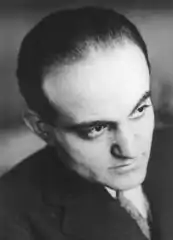Pál Kadosa
Pál Kadosa (Hungarian pronunciation: [ˈpaːl ˈkɒdoʃɒ]; 6 September 1903, Léva, Austria-Hungary (now Levice, Slovakia) – 30 March 1983, Budapest) was a pianist and Hungarian composer of the post-Bartók generation. His early style was influenced by Hungarian folklore while his later works were more toward Hindemith and expressively forceful idioms. He was born in Levice. He studied at the national Hungarian Royal Academy of Music under Zoltán Székely and Zoltán Kodály.[1] He was appointed to the faculty of the Fodor School in 1927 where he taught until 1943 when he was forced out due to wartime political issues.

In 1945 he joined the faculty of the Franz Liszt Academy where he taught, eventually becoming head of the piano department, until his death in 1983. His students included such leading musicians as György Ligeti, György Kurtág, Iván Erőd, Ferenc Rados, Arpad Joó, András Schiff, Zoltán Kocsis, Dezső Ránki, Valéria Szervánszky, Ronald Cavaye, Jenő Jandó, Kenji Watanabe, István Kassai, and Balázs Szokolay, among others..
Kadosa served on the Hungarian Arts Council and become an honorary member of the Royal Academy of Music.[2] Kadosa's work included two operas, eight symphonies, four sonatas, and six concertos.[3]
References
- Latham, Alison (January 2011). "Kadosa, Pál". Excerpt from The Oxford Companion to Music. Oxford University Press. ISBN 978-0-19-957903-7. Retrieved 3 October 2017.
- Greene, David Mason (1985). Greene's Biographical Encyclopedia of Composers. Reproducing Piano Roll Fnd. p. 1331. ISBN 9780385142786. Retrieved 3 October 2017.
- "Overview Pál Kadosa". Oxford reference, from the Oxford University Press. Retrieved October 3, 2017.
External links
 Media related to Pál Kadosa at Wikimedia Commons
Media related to Pál Kadosa at Wikimedia Commons- Dettmer, Roger. "Pál Kadosa Artist Biography". AllMusic. Retrieved 3 October 2017.